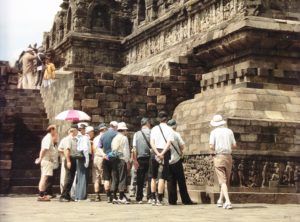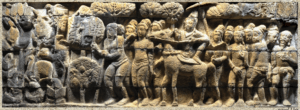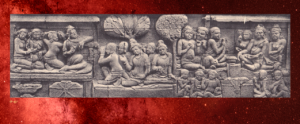Buddha Statue and Six Mudras

Besides decorated with beautiful reliefs, Borobudur Temple also has 504 statues of Buddha sitting all of which are carved on a round stone sabongkah. All the statues illustrating the Dhyani Buddha or meditating Buddhist are spread to different levels, from the lower to the top, rupadhatu and arupadhatu.
The Buddha Dhyani is different from the Buddha in history. They are not enlightened earthly beings, but they are transcendental savers who sit on their lotuses in eternal reverence, peace, and meditation with half-closed eyes.
The most striking feature of this Buddha is his simplicity. He is illustrated with a Buddha dressed in a monk’s suit in a suit with folds that fall down or almost tightly covering the body like “wet clothes”. His cloak showed only his wrists, neck, and ankles. Another physical feature is a point on his forehead, right between his eyebrows. This simplicity in Buddhist portrayal is a combination of loyalty and tenderness that produces the beauty of this statue.
Although there are similarities between them, each statue has its own personality. And in addition to his obvious personality, each statue reveals the same thing.
Sculptures at the box level are placed in a niche equipped with various ornaments. The statue is arranged in the line at the top of the outer side of the ledge. Because the higher the level has the smaller the size, the first ledge has space for 104 niches, the second is also 104 niches, the third 88 niches, the fourth 72 niches, and the fifth 64 niches. So there are 432 niches in the rupadhatu section.
Statues that are in the level of a circle placed in a hollow stupa arranged in three levels of concentric circles. The first level of the circle has 32 stupas, the second has 24 stupas, and the third has 16 stupas. Thus, there are 72 stupas which correspond to the Javanese tradition which says “72 guarded principles in a cage” in Borobudur.
Research shows significant position differences at the hands of Buddha statues in Borobudur. The left hand of the Buddha statue is generally placed in the lap with the palm facing upward, while the right-hand shows a certain gesture (mudra) associated with certain historical events of the Buddha’s life.
The Buddhas of the first 4 balustrades have different mudras, each of which has distinctive features on each side of Borobudur. The east-facing sculpture has the same mudra, and so is the patent facing west, north, and south. The Buddha at the very top, or the fifth balustrade, has the same mudra regardless of which direction they are facing. It is also the same as 72 Buddhas at the level of the circle, they all show the same hand position but are different from the mudra at the lower levels.
There are six mudras in the statue in Borobudur. The six mudras include Bhumisparcamudra (calling the earth to witness), Abhayamudra (frightening the fear), Varamudra (charity), Vitarkamudra (gesture of judgment), and Dharmacakramudra (law wheel movement).
#indonesiatourism #buddhatemple #unescoworldheritage #wonderfulindonesia


